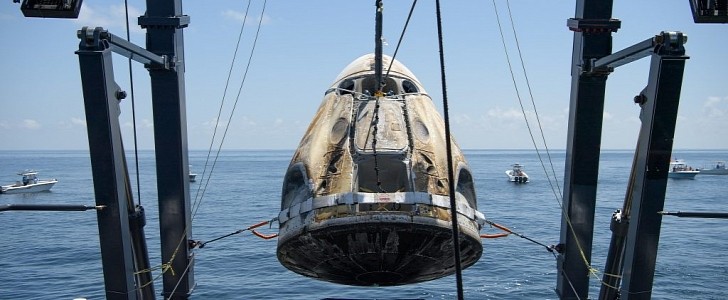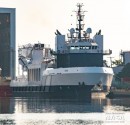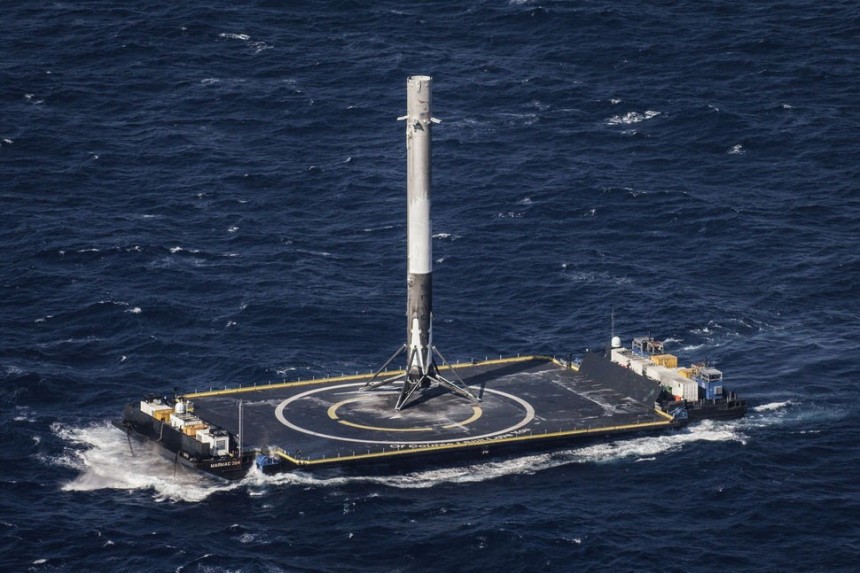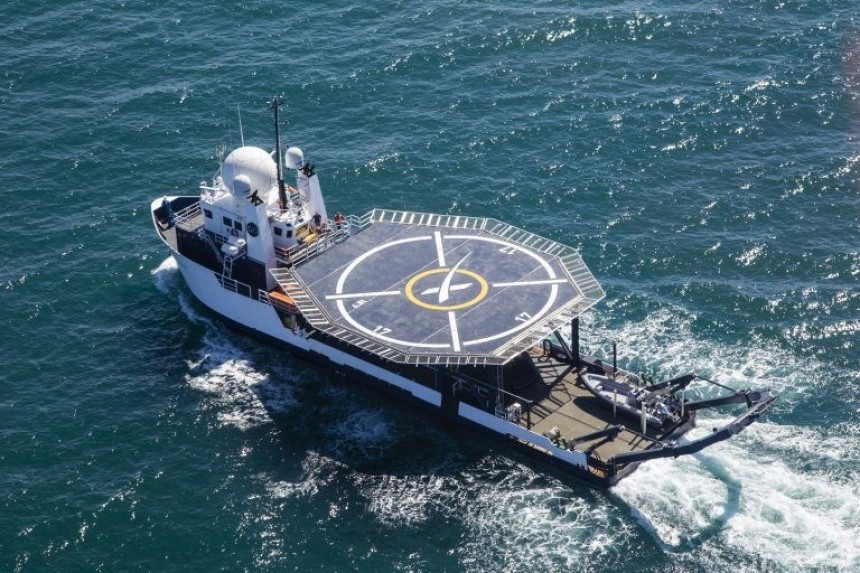A short time ago, we showed you a pair of sea vessels owned by NASA that might look like no big deal but spend their days hauling spent SRBs back to the Kennedy Space Center. Safe to say, looks can be deceiving.
But according to some people, no one does space travel better today than the free market. More often than not, this inevitatbly means Elon Musk's SpaceX. When it comes to their offshore recovery fleet, any space agency from NASA to the ESA and Roscosmos has to admit SpaceX owns a pretty impressive group of ships. Let's take a closer look at the lineup.
Even people who know nothing about space travel and have no interest whatsoever generally know the basic gist of SpaceX's grand plans. To mass produce a fleet of reusable rockets and spacecraft that haul large payloads to Low Earth Orbit and beyond while landing their booster rockets back to the surface safely for re-use. When launching from the proverbial cathedral of aerospace that is the Kennedy Space Center, that inevitably means landing these rocket stages on autonomous barges out in the ocean.
SpaceX's autonomous spaceport drone ship (ASDS) has a simple job in principle. Get tugged out to a pre-selected location in either the Atlantic Ocean in the case of KSC or the Pacific for Vandenberg AFB, allow mostly spent booster rockets to land atop them, and don't sink in the process.
Using some of the most complex guidance computers ever fitted to a rocket's first stage, spent Falcon 9 or Falcon Heavy stages use the last of their fuel reserves to lower their speed. Using the iconic X for SpaceX as reference targets to bring the rockets safely down on its deck. Usually, doing so without crashing in the process, save for a handful of times.
First tested on January 15th, 2015, SpaceX's first ASDS "Just Read the Instructions (I)" mobile rocket platform conducted two Falcon 9 landing tests in the ocean waters off the coast of Florida, both of which failed. Since then, three more ASDS vessels have been built. Just Read the Instructions (I), Of Course I Still Love You, Just Read the Instructions (II), and A Shortfall of Gravitas.
As of August 2022, over 100 landings have been conducted using ASDS vessels. Of those, only 11 failures have been reported. Not perfect by any means, but still remarkably impressive. All ASDS vessels are towed to their destinations by a plucky little tug boat lovingly named Finn Falgout. Owned and operated by Falgout Brothers Marine Company, this ordinary tug boat has served with over 20 Space X recovery missions so far.
But what about the real grand prize of the operation? Of course, we mean the Dragon crew capsule that actually houses our fragile meat bag bodies on the way in and out of space. Well, they get two of their own personal transports. One in the Atlantic Ocean and operating out of the Gulf of Mexico.
Say hello to GO Searcher (Megan) and GO Navigator (Shannon, named in honor of two pioneering NASA astronauts who later flew missions with SpaceX. Laid down in 2009 and launched in 2010, these twin diesel engine-powered vessels sail to pre-determined landing coordinates and use a combination of cranes, water pumps, and a crew of six to bring the Dragon capsule onto its deck for transport back home.
Megan joined the SpaceX recovery fleet in 2016, followed close behind by Shannon in August 2018. In their time in service with SpaceX, the twin ships have participated in over three dozen recovery missions ranging from payload fairings to fully loaded Dragon space capsules. With 1,750 horsepower worth of pulling power at their disposal, these twin ships can speed towards their intended target at a steady 22 knots (25.3 mph/ 40.7 kph).
Because SpacXs spacecraft fleet is growing ever larger, ever larger ships are needed for the recovery process. Enter Doug and Bob, two heavy-duty, multi-purpose tug/cargo vessels that are adaptable to any utility the SpaceX team might require. From tugging landing drones to retrieving Dragon space capsules, it's essentially the embodiment of the rest of the SpaceX fleet scaled up and made more capable.
Doing so while flanked by two further support ships in the Pacific Ocean, the GO Quest, and NRC West, who've been instrumental in the secondary but no less important mission of receiving SpaceX Dragon Cargo capsules off the coast of California. All in all, SpaceX currently operates three drone ships, one standard tug, four recovery vessels, and two heavy-duty utility ships. It sure outshines NASA's natively owned sea fleet. If you don't count the U.S. Navy, that is.
Check back soon for more from Sea Month and so much more here on autoevolution.
Even people who know nothing about space travel and have no interest whatsoever generally know the basic gist of SpaceX's grand plans. To mass produce a fleet of reusable rockets and spacecraft that haul large payloads to Low Earth Orbit and beyond while landing their booster rockets back to the surface safely for re-use. When launching from the proverbial cathedral of aerospace that is the Kennedy Space Center, that inevitably means landing these rocket stages on autonomous barges out in the ocean.
SpaceX's autonomous spaceport drone ship (ASDS) has a simple job in principle. Get tugged out to a pre-selected location in either the Atlantic Ocean in the case of KSC or the Pacific for Vandenberg AFB, allow mostly spent booster rockets to land atop them, and don't sink in the process.
Using some of the most complex guidance computers ever fitted to a rocket's first stage, spent Falcon 9 or Falcon Heavy stages use the last of their fuel reserves to lower their speed. Using the iconic X for SpaceX as reference targets to bring the rockets safely down on its deck. Usually, doing so without crashing in the process, save for a handful of times.
As of August 2022, over 100 landings have been conducted using ASDS vessels. Of those, only 11 failures have been reported. Not perfect by any means, but still remarkably impressive. All ASDS vessels are towed to their destinations by a plucky little tug boat lovingly named Finn Falgout. Owned and operated by Falgout Brothers Marine Company, this ordinary tug boat has served with over 20 Space X recovery missions so far.
But what about the real grand prize of the operation? Of course, we mean the Dragon crew capsule that actually houses our fragile meat bag bodies on the way in and out of space. Well, they get two of their own personal transports. One in the Atlantic Ocean and operating out of the Gulf of Mexico.
Say hello to GO Searcher (Megan) and GO Navigator (Shannon, named in honor of two pioneering NASA astronauts who later flew missions with SpaceX. Laid down in 2009 and launched in 2010, these twin diesel engine-powered vessels sail to pre-determined landing coordinates and use a combination of cranes, water pumps, and a crew of six to bring the Dragon capsule onto its deck for transport back home.
Because SpacXs spacecraft fleet is growing ever larger, ever larger ships are needed for the recovery process. Enter Doug and Bob, two heavy-duty, multi-purpose tug/cargo vessels that are adaptable to any utility the SpaceX team might require. From tugging landing drones to retrieving Dragon space capsules, it's essentially the embodiment of the rest of the SpaceX fleet scaled up and made more capable.
Doing so while flanked by two further support ships in the Pacific Ocean, the GO Quest, and NRC West, who've been instrumental in the secondary but no less important mission of receiving SpaceX Dragon Cargo capsules off the coast of California. All in all, SpaceX currently operates three drone ships, one standard tug, four recovery vessels, and two heavy-duty utility ships. It sure outshines NASA's natively owned sea fleet. If you don't count the U.S. Navy, that is.
Check back soon for more from Sea Month and so much more here on autoevolution.


















